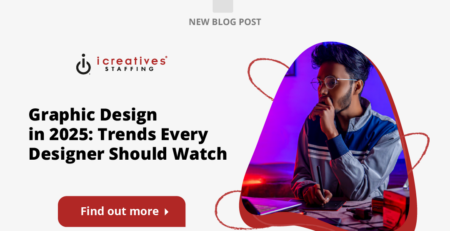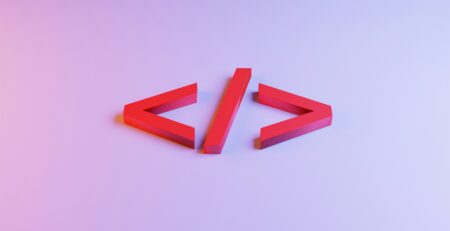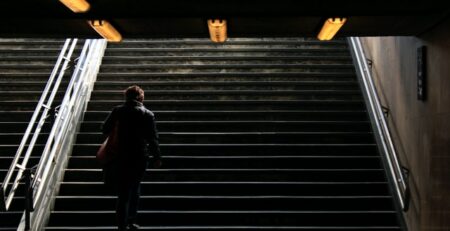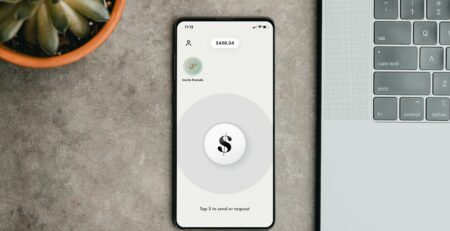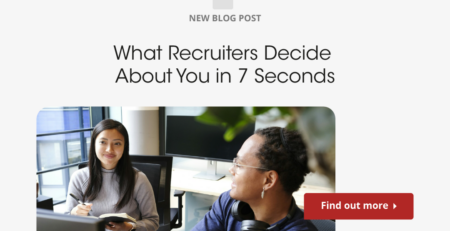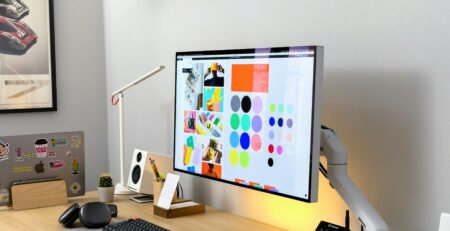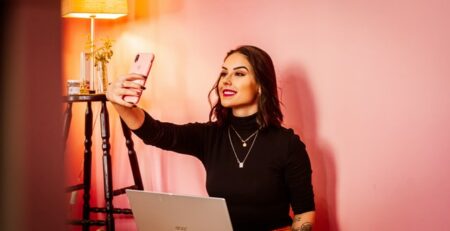Revolutionize Your Branding: Tips for Recruiting Brand Designers
Branding is a critical component of any business strategy, serving as the visual and emotional connection between a company and its customers. In today’s competitive market, having a distinctive and effective brand identity is more important than ever. This is where the expertise of skilled brand designers comes into play. Icreatives as a creative staffing agency, understanding how to recruit top-tier brand designers can significantly enhance your company’s market presence and customer engagement.
Recruiting the right brand designer is not just about filling a position but about bringing on board a visionary who can transform abstract concepts into tangible assets that resonate with the target audience. The process involves several key steps, from defining your brand’s needs to effectively integrating the designer into your team. This guide will provide you with essential tips and insights to help you navigate the complexities of recruiting brand designers, ensuring that you find a perfect match for your branding vision.
The first step in recruiting brand designers is to clearly define what your brand stands for and the goals you aim to achieve through this recruitment. Understanding your brand’s core values, target audience, and market position will help you communicate your needs more effectively to potential candidates. This clarity is crucial not only for attracting the right talent but also for setting the stage for their success within your organization.
Once you have a clear understanding of your brand’s identity and needs, the next step is to reach out to potential candidates. This involves crafting compelling job descriptions, utilizing various recruitment channels, and leveraging professional networks. A creative staffing agency can play a pivotal role in this process by tapping into their extensive network of talented designers and utilizing their expertise in identifying candidates who are a good fit for your specific requirements.
Interviewing candidates is another critical aspect of the recruitment process. This stage is not just about assessing a candidate’s technical skills and experience but also about understanding their creative process, problem-solving abilities, and cultural fit. Structured interviews, portfolio reviews, and practical assignments can provide deep insights into a candidate’s capabilities and their potential to contribute to your brand’s vision.
Another important consideration is the integration of the new designer into your team. Successful onboarding processes ensure that the designer understands their role, the company’s expectations, and how they fit into the broader organizational culture. Providing the right tools, resources, and support is essential for empowering them to make a meaningful impact quickly.
Continuous professional development is also crucial. Investing in your design team’s growth not only helps in retaining top talent but also ensures that your branding remains innovative and relevant. Workshops, seminars, and access to courses can help designers stay updated with the latest trends and technologies in brand design.
Moreover, fostering a collaborative environment where designers can share ideas, receive feedback, and feel valued is essential for nurturing creativity and innovation. Encouraging a culture of open communication and respect across different departments can lead to more cohesive and powerful brand expressions.
In conclusion, recruiting the right brand designer is a multifaceted process that requires a clear understanding of your brand’s identity, effective outreach and assessment strategies, and a supportive work environment. By following these tips, your business can make informed decisions that enhance your branding efforts and drive long-term success.

What Qualifications Should I Look for in a Brand Designer?
When recruiting a brand designer, it’s crucial to look for a combination of education, experience, and soft skills that align with your company’s branding needs. A degree in graphic design or a related field is typically essential, providing a foundational understanding of design principles and techniques. However, the most compelling qualifications extend beyond formal education.
Experience in brand design specifically, as opposed to general graphic design, is particularly valuable. Look for candidates who have a proven track record of successful brand projects, as this shows they can handle the complexities and nuances of brand-specific work. Their portfolio should demonstrate a strong aesthetic sense and the ability to adapt their style to match different brand identities.
Soft skills such as creativity, communication, and problem-solving are equally important. A brand designer must be able to think creatively to develop unique branding concepts that stand out in the market. Strong communication skills are essential for effectively articulating design ideas and collaborating with other team members, including marketers and product developers.
Technical skills in design software such as Adobe Creative Suite are a given, but familiarity with web design and multimedia software can be a significant plus, broadening the scope of what the designer can contribute to your branding efforts. Additionally, an understanding of marketing and consumer psychology can greatly enhance a designer’s ability to create visually appealing designs that resonate with the target audience.
When assessing qualifications, consider the specific needs of your brand. For instance, if your company frequently works with digital media, a designer with strong digital and interactive design skills would be ideal. Similarly, if your brand has a global reach, a designer with experience in multicultural marketing might be particularly beneficial.
It’s also beneficial to consider a candidate’s potential for growth and adaptability. The branding industry is dynamic, and the ability to learn new skills and adapt to emerging trends can be more valuable than current knowledge alone. During the interview process, ask questions that gauge a candidate’s willingness to learn and adapt.
Finally, cultural fit is an important consideration. A designer who shares your company’s values and vision is more likely to contribute positively and stay with your company longer. Assessing cultural fit can be subjective, but it is crucial for ensuring a harmonious and productive work environment.
In summary, the ideal qualifications for a brand designer include a balanced mix of education, experience, technical and soft skills, along with a strong alignment with your company’s culture and values. By carefully considering these factors, you can recruit a designer who will not only enhance your branding efforts but also contribute to the overall success of your company.
How Do I Evaluate a Brand Designer’s Portfolio?
Evaluating a brand designer’s portfolio is a critical step in the recruitment process, as it provides tangible evidence of the designer’s style, expertise, and suitability for your brand. A well-rounded portfolio should showcase a variety of projects that highlight the designer’s range and ability to adapt to different brand aesthetics and requirements.
When reviewing a portfolio, first look for relevance to your specific needs. If your company needs a designer for a rebranding project, for example, look for examples of successful rebranding initiatives the designer has undertaken. This relevance can often be more telling than the overall size or diversity of the portfolio.
Quality over quantity is a key principle when evaluating design work. Pay attention to the details and craftsmanship in each piece. High-quality visuals, attention to typography, color theory, and composition are indicators of a skilled designer who takes pride in their work.
Another important aspect to consider is the designer’s ability to solve problems and meet business objectives through their designs. Look for case studies or project descriptions that explain the designer’s thought process and how the design achieved its goals. This insight can help you understand how the designer approaches challenges and whether their style of problem-solving aligns with your needs.
It’s also useful to assess the designer’s versatility by looking at different types of design work in their portfolio. A designer who can create both print and digital assets, for example, may be more adaptable to the varying needs of your brand campaigns.
Client feedback or testimonials included in the portfolio can also be a valuable source of insight into the designer’s reliability, professionalism, and ability to collaborate with clients. Positive feedback from past clients can be a strong indicator of a designer’s potential to be a valuable addition to your team.
Additionally, consider the context in which the work was created. Understanding whether a project was for a small startup or a large corporation can provide context that helps you gauge how well the designer can handle the scale of projects your company typically undertakes.
Interactive elements in the portfolio, such as digital interfaces or web design work, should be functional and user-friendly, indicating the designer’s ability to apply good UX principles. This is particularly important if your brand operates in the digital space.
Lastly, during the portfolio review process, it can be beneficial to have a dialogue with the designer about their work. This conversation can provide deeper insights into their creative process, their role in team projects, and their ability to articulate and defend their design choices.
In conclusion, a thorough evaluation of a brand designer’s portfolio should focus on the relevance, quality, problem-solving ability, versatility, and client feedback. Engaging with the designer about their work can further aid in assessing their suitability for your brand’s needs.

What Are Effective Interview Techniques for Brand Designers?
Interviewing brand designers requires a tailored approach that not only assesses their technical skills and experience but also evaluates their creative thinking, problem-solving abilities, and cultural fit. Effective interview techniques can help you gain a comprehensive understanding of the candidate’s potential to contribute to your brand’s vision.
One effective technique is to start with open-ended questions that allow the designer to discuss their professional journey and philosophy. Questions like “Can you describe your design process?” or “What design project are you most proud of and why?” can provide insights into their creative process and priorities.
Behavioral interview questions are also crucial as they help you understand how the candidate has handled specific situations in the past. Asking questions such as “Can you tell me about a time when you had to overcome a significant challenge in a design project?” or “How do you handle feedback that you disagree with?” can reveal the candidate’s problem-solving skills and their ability to work collaboratively.
A practical component, such as a design challenge or a portfolio review, can be very telling. Giving the candidate a small, time-bound task related to your brand can help you assess their skills in action. Alternatively, asking them to walk you through their portfolio and discuss their design choices provides insights into their thought process and technical expertise.
It’s also beneficial to include team members from different departments in the interview process, especially those who will work closely with the designer. This can help assess the candidate’s ability to communicate and collaborate with cross-functional teams.
Asking about the candidate’s career aspirations and expectations from the role can help determine alignment with your company’s long-term goals. This discussion can also reveal the candidate’s motivation and commitment to the field of brand design.
Another technique is to discuss hypothetical scenarios related to your brand’s current challenges. This can help you understand how the designer would approach real-world problems specific to your business.
It’s important to create a comfortable environment during the interview, as this can encourage the candidate to open up and share more about their capabilities and personality. A relaxed conversation can often yield more in-depth insights than a strictly formal interview.
Finally, always provide an opportunity for the candidate to ask questions. This not only helps them understand the role and the company better but also demonstrates their level of interest and engagement with your brand.
In conclusion, effective interview techniques for brand designers should combine structured questions, practical assessments, and interactive discussions. This approach helps in thoroughly evaluating the candidate’s technical abilities, creative thinking, and cultural fit, ensuring that you select the best talent to drive your brand forward.
How Can I Attract Top Brand Design Talent to My Company?
Attracting top brand design talent requires a strategic approach that highlights your company’s unique offerings and aligns with the aspirations of creative professionals. In today’s competitive job market, designers are looking for roles that offer not only good compensation but also opportunities for growth, creativity, and impact.
Firstly, ensure that your company culture is appealing to creative talent. Designers thrive in environments that value creativity, innovation, and collaboration. Highlight aspects of your company culture that are conducive to creative work, such as flexible work hours, a supportive team environment, and opportunities for creative freedom.
Offering competitive compensation packages is also crucial. This includes not only salaries but also benefits like health insurance, retirement plans, and bonuses. Additionally, providing perks specific to creative work, such as budgets for professional development, subscriptions to design software, or attendance at industry conferences can make your offer more attractive.
Develop a strong employer brand that resonates with creative professionals. This can be achieved through a well-designed company website, active social media presence, and engaging content that showcases your company’s projects, success stories, and the impact of your work. Highlighting how your company’s work aligns with broader social or environmental goals can also appeal to designers who are looking to make a difference through their work.
Utilize industry-specific job boards and professional networks to post your job openings. Platforms like Behance, Dribbble, and AIGA offer access to a large pool of qualified designers. Additionally, attending industry conferences and networking events can help you connect directly with potential candidates and promote your company as an exciting place to work.
Implementing an employee referral program can also be effective. Your current employees might know talented designers looking for new opportunities. Offering incentives for successful referrals can motivate your team to help recruit top talent.
Another strategy is to collaborate with educational institutions that offer design programs. This can help you tap into emerging talent and build relationships with young designers who are about to enter the job market.
Transparency in the recruitment process is also key. Be clear about the role, expectations, and the career path within your company. Honest communication about the challenges and rewards of the position can help set realistic expectations and attract candidates who are a good fit.
Finally, consider working with a creative staffing agency. These agencies specialize in matching companies with creative talent and can significantly streamline the recruitment process. They understand the nuances of recruiting for creative roles and can help you find candidates who not only have the right skills but also fit well with your company culture.
In conclusion, attracting top brand design talent involves creating a work environment that values creativity, offering competitive compensation, and actively promoting your company in the creative community. By implementing these strategies, you can attract skilled designers who are eager to contribute to your brand’s success.
What Are Common Challenges in Recruiting Brand Designers and How to Overcome Them?
Recruiting brand designers presents several challenges, from identifying the right talent to ensuring a good fit with your company’s culture. Understanding these challenges can help you develop more effective recruitment strategies.
One of the main challenges is the high demand for skilled designers. With many companies vying for the same talent, it can be difficult to attract top designers to your organization. To overcome this, focus on building an attractive employer brand that highlights your company’s unique qualities and the benefits of working with you.
Another challenge is assessing a candidate’s true creative ability and potential to innovate. Traditional recruitment methods may not always be effective in evaluating these qualities. Incorporating practical assignments or design challenges into the interview process can provide better insights into a candidate’s creativity and problem-solving skills.
Cultural fit is also crucial and can be difficult to assess accurately. To address this, involve various team members in the recruitment process to get a well-rounded view of how the candidate interacts with potential colleagues. Additionally, clearly communicating your company’s values and culture through your recruitment materials and interviews can help attract candidates who align with them.
Keeping up with the latest trends and technologies in design can also be a challenge. To attract knowledgeable and skilled designers, offer continuous learning opportunities and access to the latest tools and resources. This not only helps in recruiting but also in retaining talent.
Finally, the logistical aspects of recruitment, such as coordinating interviews and following up with candidates, can be time-consuming. To streamline these processes, consider using recruitment software or working with a creative staffing agency that specializes in placing brand designers.
By understanding and addressing these challenges, you can improve your recruitment strategies and increase your chances of hiring designers who will contribute positively to your brand’s success.
How Do I Integrate a New Brand Designer into My Existing Team?
Integrating a new brand designer into an existing team is crucial for ensuring their effectiveness and satisfaction with their role. A smooth integration process can foster collaboration, enhance creativity, and contribute to the overall success of your branding projects.
Start by planning a comprehensive onboarding process. This should include introductions to key team members, an overview of ongoing projects, and a clear outline of the designer’s role and responsibilities. Providing a mentor or a point of contact who can help the new designer navigate the company culture and processes can also be beneficial.
It’s important to set clear expectations from the beginning. Discuss the goals, deadlines, and standards of work expected, and provide feedback regularly. This helps the new designer understand their role and how they can contribute to the team’s objectives.
Encourage open communication and provide opportunities for the new designer to share their ideas and insights. This not only helps them feel valued but can also bring fresh perspectives to your projects.
Facilitate team-building activities that help integrate the new designer with the rest of the team. These can range from formal workshops to informal social events. Building a strong team dynamic is essential for effective collaboration and creativity.
Provide access to all the tools and resources the designer needs to perform their job effectively. This includes software, design assets, and any company-specific documentation that can help them produce their best work.
Monitor the integration process and check in regularly with the new designer to address any concerns or challenges they may face. This ongoing support is crucial for their success and satisfaction in their role. Regular check-ins also demonstrate your commitment to their professional growth and well-being within the company.
Encourage the new designer to participate in decision-making processes. This inclusion not only boosts their confidence but also helps them feel more connected to the team and the projects they are working on. It’s important for new hires to feel that their opinions are valued and that they can impact the outcome of projects.
Consider setting up a structured feedback loop where the new designer can receive constructive criticism and praise. This should be a balanced approach that not only highlights areas for improvement but also acknowledges their contributions and successes. Feedback is a powerful tool for professional development and helps in fine-tuning skills that are crucial for brand design.
Lastly, be patient and provide a supportive environment that allows the new designer to gradually adapt to the new role and company culture. Every individual has a unique pace of learning and adjusting, and providing the space to grow at their own pace can lead to better long-term results for both the designer and the company.
In conclusion, integrating a new brand designer into an existing team involves a combination of structured onboarding, clear communication, inclusive practices, and ongoing support. By carefully managing this process, you can help your new hire become a valuable and effective member of your team, contributing to the overall success and creativity of your branding efforts.
What Are the Best Practices for Retaining Top Brand Design Talent?
Retaining top brand design talent is crucial for maintaining the consistency and quality of your brand’s visual identity. It also helps in building a stable and experienced team that can drive your company’s creative initiatives. Here are some best practices for keeping your top designers motivated and committed to your company.
First, provide competitive compensation and benefits. This includes not only fair salaries but also bonuses, health benefits, retirement plans, and other perks that contribute to job satisfaction and financial security. Regularly reviewing and adjusting compensation packages can help keep your offers competitive in the market.
Offer opportunities for career advancement and professional development. Designers are often driven by the desire to improve their skills and take on new challenges. Providing access to training programs, workshops, and seminars can help them stay updated with the latest design trends and technologies.
Create a positive and creative work environment. Encourage a culture of innovation, where designers feel free to express their ideas and take creative risks. Recognizing and rewarding creative achievements can also boost morale and motivation.
Encourage work-life balance. This can be achieved through flexible working hours, the option to work remotely, and ensuring that workloads are manageable. A healthy work-life balance is essential for long-term job satisfaction and can reduce burnout among creative professionals.
Involve designers in strategic discussions about the brand’s direction. This inclusion not only makes them feel valued but also allows them to contribute more effectively to the company’s goals. Designers who feel their work has a significant impact are more likely to remain committed to the company.
Provide clear pathways for feedback and communication. Designers should feel that their opinions are heard and that there is a transparent process for addressing any issues or concerns they may have. This open communication helps in building trust and loyalty.
Lastly, celebrate successes and milestones. Whether it’s the successful launch of a new brand campaign or a designer’s work anniversary, acknowledging and celebrating these achievements can foster a sense of accomplishment and belonging.
In conclusion, retaining top brand design talent requires a holistic approach that includes competitive compensation, opportunities for growth, a positive work environment, work-life balance, strategic inclusion, open communication, and recognition of achievements. By implementing these best practices, you can ensure that your top designers remain engaged and motivated to contribute to your brand’s success.
Conclusion
In the dynamic field of brand design, recruiting and retaining top talent is essential for maintaining a competitive edge. From understanding the qualifications needed in a brand designer to integrating them into your team and ensuring their long-term retention, each step requires careful consideration and strategic planning. By following the tips and insights provided in this guide, you can enhance your recruitment processes, foster a creative and productive work environment, and ultimately drive your brand towards greater success.
Remember, the key to successful branding lies not just in the visual appeal of your designs but in the continuous innovation and deep understanding of your audience’s needs and preferences. Investing in the right talent is crucial in achieving this goal. With the right team in place, your brand can thrive in today’s competitive market, creating lasting impressions and building strong connections with your customers.For more insights on managing creative teams and maximizing productivity, consider exploring additional resources such as Tips for Managing a Remote Work Force and How to Become an Effective Remote Manager. These articles provide valuable information that can help you further enhance your management skills and adapt to the evolving demands of the creative industry.
In today’s competitive market, finding the right creative and marketing expert can be a challenge. But with icreatives, you’re in experienced hands. With 37 years in staffing and a track record of matching more than 10,000 employees to over 1,000 companies worldwide, we know how to connect you with the best. Plus, you only pay if you hire—there’s no risk, only results.
Ready to find your perfect creative or marketing expert? HIRE WITH ICREATIVES today!


